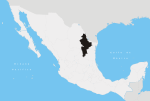Nuevo León
| Nuevo León Estado Libre y Soberano de Nuevo León |
|||
|---|---|---|---|
| — State — | |||
|
|||
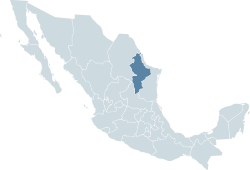 |
|||
| Coordinates: | |||
| Country | |||
| Capital | Monterrey | ||
| Municipalities | 51 | ||
| Largest City | Monterrey | ||
| Admission | May 7, 1824[1] | ||
| Order | 15th | ||
| Government | |||
| - Governor | Rodrigo Medina de la Cruz( |
||
| - Federal Deputies | PAN: 7 PRI: 5 |
||
| - Federal Senators | PAN :2 PRI: 1 |
||
| Area Ranked 13th |
|||
| - Total | 64,210 km2 (24,791.6 sq mi) | ||
| Population (2005) | |||
| - Total | 4,199,292 (Ranked 8th) | ||
| Time zone | CST (UTC-6) | ||
| - Summer (DST) | CDT (UTC-5) | ||
| HDI (2004) | 0.872 - high Ranked 3nd |
||
| ISO 3166-2 | MX-NLE | ||
| Postal abbr. | N.L. | ||
| Website | Nuevo León State Government | ||
Nuevo León (Spanish pronunciation: [ˈnweβo leˈon], New León) is a state located in northeastern Mexico. It borders the states of Tamaulipas to the north and east and San Luis Potosí to the south, and Coahuila to the west. To the north, Nuevo León accounts for a 15 kilometer (9 mi) stretch of the U.S.-Mexico border adjacent to the U.S. state of Texas.
The capital of Nuevo León is Monterrey, other important cities include Guadalupe, Santa Catarina, San Nicolás de los Garza, and San Pedro Garza García, all of which are part of the Monterrey Metropolitan area.
Contents |
History
It was originally founded by Alberto del Canto, although frequent raids by Chichimecas, the natives of the north, prevented the establishment of almost any permanent settlements. Subsequent to the failure of del Canto to populate Nuevo León, Luis Carvajal y de la Cueva, at the head of Portuguese and Spanish settlers, requested permission from the Spanish King to attempt to repopulate the area which would be called the New Kingdom of León, it eventually became (along with the provinces of Coahuila, Nuevo Santander and Texas) one of the Eastern Internal Provinces in Northern New Spain.[2][3]
In the 19th century, Nuevo León was in a growth spurt and the bargain land deals attracted immigrants of German, Slavic, French, Italian, Jewish and Anglo-American origin. The capital of Nuevo León is Monterrey, the third largest city in Mexico with over four million residents. Monterrey is a modern and affluent city, and Nuevo León has long been one of Mexico's most industrialized states.
Geography
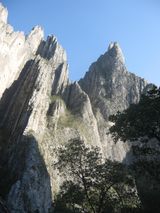
Nuevo León has an extreme climate, and there is very little rainfall throughout the year. The territory covers 64,924 square kilometers (25,067.3 sq mi), and can be divided into three regions: a hot, dry region in the north, a temperate region in the mountains, and a semi-arid region in the south. The Sierra Madre Oriental mountain range affects in an important way the lay of the land forming the Galeana and Doctor Arroyo plateaus, the Iguana, Picachos, Papagayos, and Santa Clara mountain ranges, and the Pilón, Ascensión, and Río Blanco valleys. As for hydrography, the San Juan River supplies the El Cuchillo dam, which provides water for Monterrey and the metropolitan area. There are also the Cerro Prieto, La Boca, Vaquerías, Nogalitos, and Agualeguas dams. Laguna de Labradores is a major lake in Nuevo León, and Pozo del Gavilán is a natural well. Both are located in the Galeana municipality. The flora of the region includes brush and pastures in the low regions, and pine and oak trees in the mountains. The fauna includes black bears, mountain lions, javelinas, praire dogs, foxes, coyotes, and white-tailed deer, along with smaller species.
Climate
Nuevo León has many biomes, which is why it has different climates. Some areas in the mountains are very cold in winter and temperate in summer. In the northern part of the state the climate is arid as a result of the proximity to the Chihuahuan desert. Extreme high temperatures of 47 °C or more occur on the desert areas while winters are short and mild. In Monterrey the climate is semi-arid with extreme hot summers and mild winters. There is very little rainfall throughout the year, usually about 500 mm or less.
| Monterrey | ||||||||||||||||||||||||||||||||||||||||||||||||||||||||||||
|---|---|---|---|---|---|---|---|---|---|---|---|---|---|---|---|---|---|---|---|---|---|---|---|---|---|---|---|---|---|---|---|---|---|---|---|---|---|---|---|---|---|---|---|---|---|---|---|---|---|---|---|---|---|---|---|---|---|---|---|---|
| Climate chart () | ||||||||||||||||||||||||||||||||||||||||||||||||||||||||||||
|
||||||||||||||||||||||||||||||||||||||||||||||||||||||||||||
|
||||||||||||||||||||||||||||||||||||||||||||||||||||||||||||
| Anáhuac | ||||||||||||||||||||||||||||||||||||||||||||||||||||||||||||
|---|---|---|---|---|---|---|---|---|---|---|---|---|---|---|---|---|---|---|---|---|---|---|---|---|---|---|---|---|---|---|---|---|---|---|---|---|---|---|---|---|---|---|---|---|---|---|---|---|---|---|---|---|---|---|---|---|---|---|---|---|
| Climate chart () | ||||||||||||||||||||||||||||||||||||||||||||||||||||||||||||
|
||||||||||||||||||||||||||||||||||||||||||||||||||||||||||||
|
||||||||||||||||||||||||||||||||||||||||||||||||||||||||||||
Demography
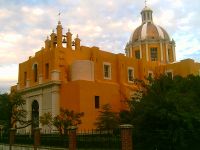
As of 2005, Nuevo León's population was about 4.1 million. Nearly 80% of the state's population resides within the Monterrey Metropolitan area.
Life expectancy is high, reaching 73 years for men and no less than 79 years of age for women. On the other hand, 94% of the total population occupy urban areas, one million of which are home-owners, and 90% of which enjoy running water, sewer systems and electric power.
Following the nation's tendency, a majority of the population identifies as being Roman Catholic.
Major communities
- Apodaca
- Cadereyta Jiménez
- Ciudad Benito Juárez
- General Escobedo
- Guadalupe
- Linares
- Monterrey
- Sabinas Hidalgo
- San Nicolás de los Garza
- San Pedro Garza García
- Santa Catarina
Education
The high quality of life that prevails across the state is reflected on statistical rates such as education, as the entity reports an almost perfect record for finished secondary education, and 13 in 100 inhabitants earn a professional degree. In the same line, illiteracy rates for the state are within the lowest in the nation at 2,8%, just behind the Distrito Federal which still leads the country in this regard.
Institutions of higher education include:
- Universidad Autónoma de Nuevo León (UANL)
- Instituto Tecnológico y de Estudios Superiores de Monterrey (ITESM)
- TecMilenio University (UTM)
- Universidad de Montemorelos
- Universidad Regiomontana (UR)
- Universidad de Monterrey (UDEM)
Economy
Highly industralized, Nuevo León possesses a standard of living similar to that of countries such as Croatia, Slovakia or Poland. In 2007, the per capita GDP of the state was similar to that of the Asian Tiger of South Korea and even higher than that of some European Union states such as Slovakia and Hungary. At $26,658, it was the highest GDP per capita (PPP) of any Mexican state (not counting the Federal District), and was therefore higher than the Mexican national average (2007 GDP per capita (PPP) national average was $14,119).[4][5]
One of its municipalities, San Pedro Garza García, has the highest income per capita in Mexico. It is also home of powerful conglomerates, such as Cemex (third largest cement company in the world, after Lafarge and Holcim), Bimbo (bakery and pastry), Maseca (food and grains), Banorte (the only high-street bank in Mexico wholly owned by Mexicans), ALFA (Sigma, Alestra, Nemak, Alpek and Hylsa (recently bought by Ternium), i-service (HelpDesk), Vitro SA (glass), FEMSA (Coca-Cola in Latin America), and Cervecería Cuauhtémoc Moctezuma (brewers of Sol, Tecate, XX, Bohemia, Indio and Nochebuena).
Nuevo Leon also boasts a rich agricultural core, called the "orange belt", which comprises the municipalities of Allende, Montemorelos, Hualahuises, General Teran and Linares. Small but productive investments have been transforming traditional harvests (mainly based on orange and cereals) into agroindustrial developments that are producing increasing revenues for the local economy.
In contrast with the relative wealth of industrial Nuevo Leon and the orange belt, the Southern part of the state (municipalities of Galeana, Aramberri, Zaragoza, Doctor Arroyo and Mier y Noriega) remains rural and less productive. Most of The South of the state is at the mercy of a very dry weather that represents a major hurdle for agriculture and livestock.
As of 2007, Nuevo León’s economy represents 11.4% of Mexico’s total gross domestic product or 105 billion USD.[6] Nuevo León's economy has a strong focus on export oriented manufacturing (i.e. maquiladora / INMEX). As of 2005, 431,551 people are employed in the manufacturing sector.[7] Foreign direct investment in Nuevo León was 1,213.1 million USD for 2005. In recent years, the state government has been making efforts in attracting significant investments in aeronautics, biotechnology, mechatronics, information and communication technologies fields with the creation of the Research and Technology Innovation Park PIIT (Parque de Investigación e Innovación Tecnológica), a technology park oriented in the development, innovation and research of sciences. The project is one of the key strategies within the Monterrey, international City of Knowledge program. The park is located in the municipality of Apodaca, part of Greater Monterrey at the 10 km of the highway to Monterrey’s International Airport. It consists of a total surface area of 70 Ha (172 acres), half of it already committed to R&D centers. The other 35 Ha (86 acres) are available for research and development centers, and for businesses that meet the Park’s objectives. [8][9]
Government
See main article Politics and government of Nuevo León.
Official name: Estado Libre y Soberano de Nuevo León (Free and Sovereign State of Nuevo León). Official motto: Latin: Semper Ascendens (Always Ascending).
Type of government: Republican and representative according to 30th article of the local constitution.
|
||||||||||||||
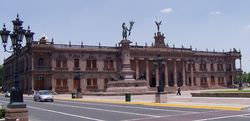
Executive: In 6 July 2003 gubernatorial election, Alianza Ciudadana – an electoral alliance between the Institutional Revolutionary Party (PRI) and the Green Ecological Party of Mexico (PVEM) – regained control of the state from President Fox's party National Action Party (PAN). The new governor, Natividad González Parás of the PRI, was sworn in on 4 October 2003 for a period of six years.
Cabinet: Chosen directly by the Governor except for the General Comptroller and the State General Attorney, which are elected by Congress from a list of names provided by the Governor.
Legislative: The State has a unicameral chamber. The LXXI Congress of Nuevo León is composed of 42 deputies, 26 of them chosen by first-past-the-post electoral districts and 16 of them by proportional representation on a party-list basis. The parties represented are the PRI with 15 deputies, the PAN with 22 deputies, the Partido del Trabajo (PT) with two deputies, the Party of the Democratic Revolution (PRD) with one, and the New Alliance party (PANAL) with two deputies.
Judiciary: Judicial power rests in the Superior Court of Justice of Nuevo León, led by Minister Gustavo Adolfo Guerrero Gutiérrez.
Political parties: Official recognition is given by the State Electoral Commission to those parties getting more than 1.5% of the votes in the last election (Art.40 of the State Electoral Law), which are the ones represented in Congress.
Municipalities
Nuevo León is divided into 51 municipalities (municipios). See municipalities of Nuevo León.
See also
- History of Nuevo León
- Fiestas of Nuevo León
Sources
- Human Development Report for Mexico 2002
- (Spanish) Historia de Nuevo León by Israel Cavazos
- (Spanish) Enciclopedia de los Municipios de México
- (Spanish) Comisión Estatal Electoral de Nuevo León
- (Spanish) Ley Estatal Electoral de Nuevo León, 1996
References
- ↑ "La diputación provincial y el federalismo mexicano" (in Spanish). http://books.google.com.mx/books?id=i_GK_-6deKIC&pg=PA227&lpg=PA227&dq=22+De+Mayo+De+1824+durango&source=bl&ots=eyvDzsrMIz&sig=zYxzmtG7gTQgGV-WNDfHgqcG_kU&hl=es&ei=FtAxS9joN56ltgf-_ojFDg&sa=X&oi=book_result&ct=result&resnum=1&ved=0CAgQ6AEwAA#v=onepage&q=22%20De%20Mayo%20De%201824%20durango&f=false.
- ↑ Gerhard, Peter. The North Frontier of New Spain. Princeton, Princeton University Press, 1982.
- ↑ En los albores de la independencia: Las Provincias Internas de Oriente durante la insurrección de don Miguel Hidalgo y Costilla, 1810-1811. by Isidro Vizcaya Canales
- ↑ INEGI, Población total por entidad federativa según sexo, 2000 y 2005 and PIB estatal
- ↑ http://sg.nl.gob.mx/DataNL/files%5CDNL00000431.pdf
- ↑ Industrial Costs in Mexico - A Guide for Foreign Investors 2007. Mexico City: Bancomext. 2007. pp. 96.
- ↑ Industrial Costs in Mexico - A Guide for Foreign Investors 2007. Mexico City: Bancomext. 2007. pp. 92.
- ↑ "Research and Technology Innovation Park PIIT". http://www.piit.com.mx/?p=&i=e.
- ↑ "Monterrey, city of knowledge". http://www.mtycic.org/.
External links
- (Spanish) Nuevo León State Government
|
|||||||||||||||||
|
|||||
|
||||||||||

